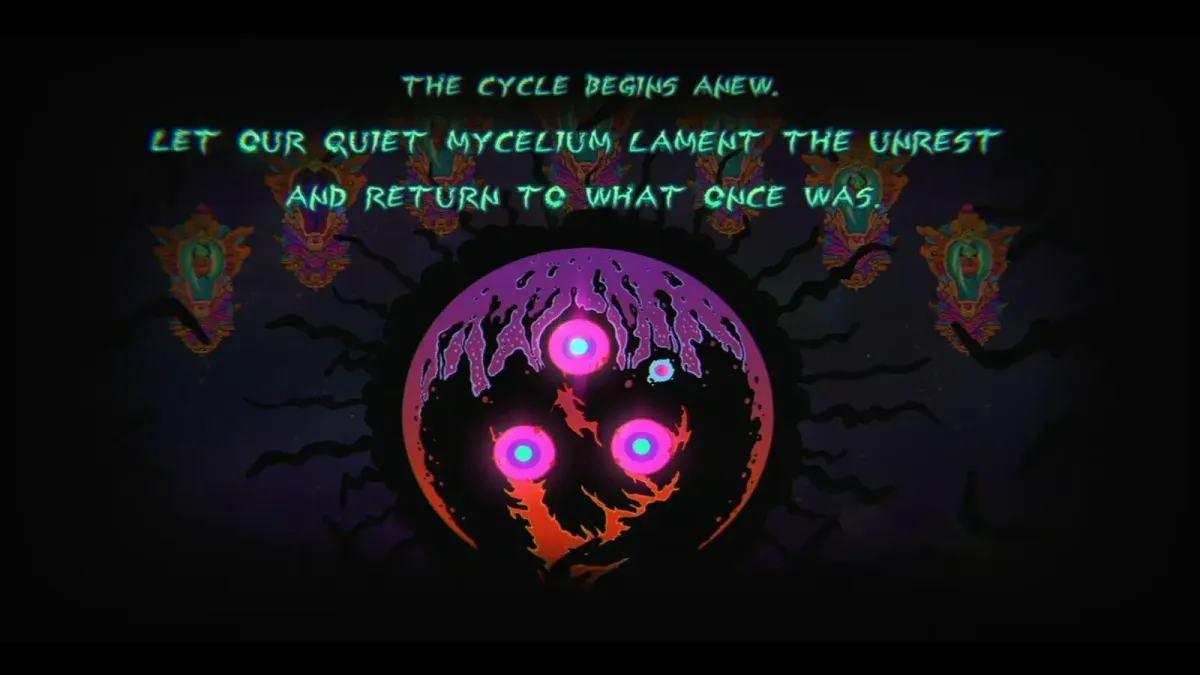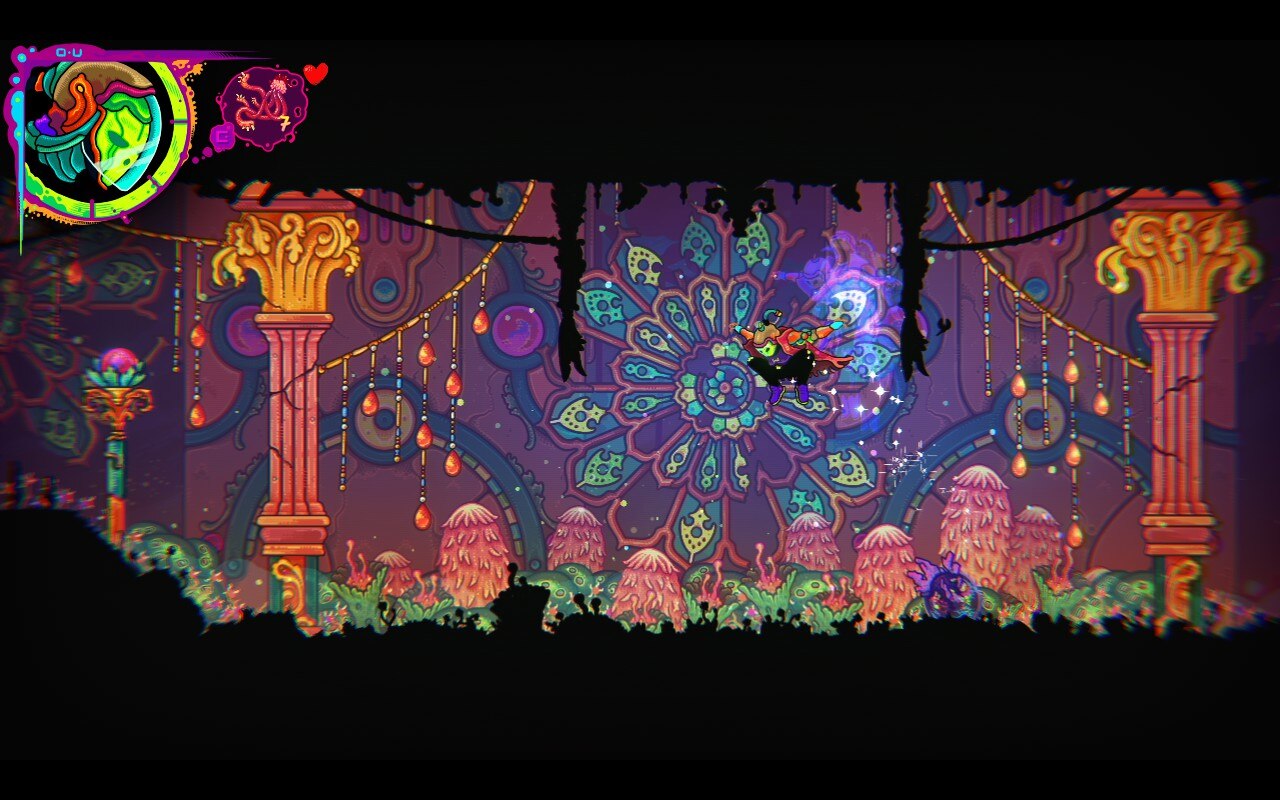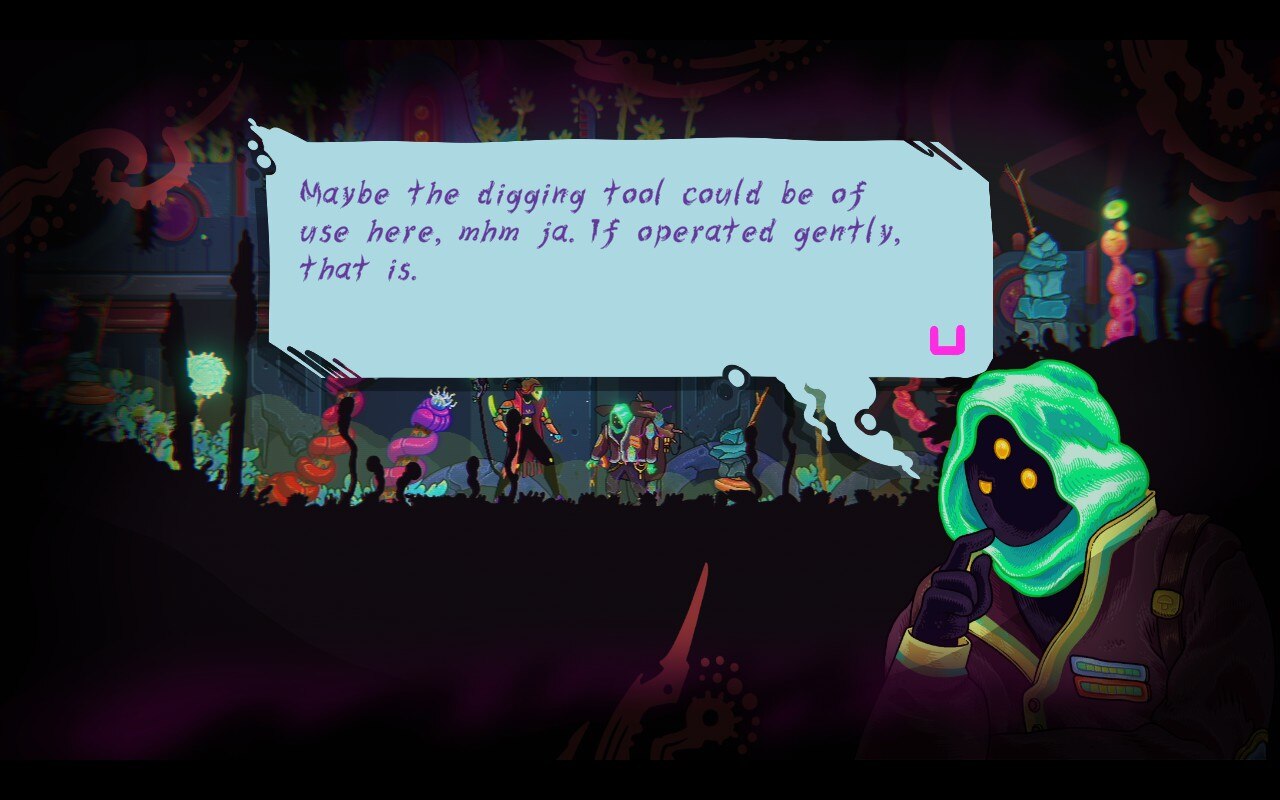
Ultros undoubtedly stands out. With its radical visual style and a horde of unusual subsystems, you won’t be confusing it with the mountain of other games “like Metroid” available these days. Those distinctive flairs are Ultros’s greatest strengths and its greatest weaknesses. Ultros cleverly reinterprets a familiar game structure to do new things, yet I came away from the experience thinking that Ultros may be too clever for its own good. In the search for ingenuity, it often sacrifices playability, resulting in a game carried by its style over its subsystems.
Nothing beats being cool and mysterious. I spent a large chunk of my time playing this game not understanding much about it. I wouldn’t have it any other way! To an extent, it’s admirable and even a little desirable for a game to make you uncomfortable. Ultros nails that. Colorful visuals, strange environments, and a cryptic narrative immediately pull you into this game’s world. Ultros compels you to explore based on the strengths of its style alone.
While the general atmosphere of the game may be purposefully uncomfortable, the gameplay itself matches to questionable effect. Your character moves with a noticeable weight to their actions. I adjusted after a while, but everything from their movement to their attacks feels slightly off, making for a bitter first impression. It’s not an automatic negative for a game to forgo fluid controls, and I’d hesitate to say they hinder the game in any serious way, but it’s something that lingered in the back of my mind as I played. This small seed of discomfort would later be fertilized as I discovered the true nature of Ultros.
The unusual feel of the game avoids harming it largely due to the nature of its design. Ultros features an interconnected map full of platforming and hostile creatures, yet neither of those obstacles poses much of a threat. Only a handful of different enemy types exist and even the most formidable foes can be bested simply by rolling behind them or breaking their shield with a charged attack. Similarly, the bizarre nature of the terrain belies how straightforward it tends to be to traverse.
Although I didn’t understand much about Ultros during my initial play sessions, it became increasingly clear that its “core” gameplay wasn’t the draw. Instead of its striking aesthetic or even the primary mechanics of the game, Ultros wants you to focus on the subsystems lurking behind the scenes. It’s a risky approach. The full nature of these seemingly tertiary features remains shrouded for a large portion of the game. I suspect a lot of people won’t have the patience to appreciate it all. Honestly, after completing the game, I realized that I didn’t really have the patience for it.
It becomes apparent early on that the world of Ultros takes place in a time loop. Whenever you reach a specific point in the game, it will essentially start back over from the beginning. Your character resets as well – all your upgrades will be gone at the start of every loop.
This process both is and isn’t as bad as it sounds. It isn’t that bad because you regain your abilities relatively quickly. It is bad because the first few loops drag out the process of regaining your abilities the longest while also forcing you to retrace the most steps. How the game handles the initial looping demonstrates part of why I feel like the game may be too clever. Ultros obviously wants the player to understand the full impact of the looping system early on but executes that goal in a tedious way that most will likely resent.
Of course, looping allows for some interesting ideas. For example, although your character loses most of their abilities at the end of each loop, that doesn’t need to be the case. By finding hidden collectibles, you can “pin” your different unlocked abilities and have them ready to go at the beginning of the next loop. I like the gist of this idea; it gives you a nonlinear approach to developing your character along with some strategic considerations about what’s best to pin. Do you go for something expensive to unlock or something convenient for the starting areas? The upgrades themselves let this idea down a bit, unfortunately. Most of the movement abilities lack straightforward utility to a surprising degree and the combat upgrades come across as superfluous due to the low difficulty of the game.
The real draw of looping goes hand-in-hand with the other major subsystem: planting. As you explore and fight enemies, you’ll collect fruits and seeds. Seeds can be planted at designated soil plots, spawning a larger plant. These plants provide a bountiful harvest of benefits like spawning health, creating new platforms, or nullifying obstacles. Plants survive the looping and grow more powerful with the passage of time. This means that placing the right plants at the right places while taking advantage of the loop system, you can turn the world of Ultros into your personal garden of convenience.
However, I found that the logistics of this system hampered its ambition. To put it bluntly, I don’t think the planting system is that fun to interact with. For starters, it’s an oddly convoluted system. I constantly forgot what a seed would sprout and even occasionally confused one seed with another. Some seeds look similar and the names are nearly impossible to remember in general. This meant I would often need to cycle through my seeds in a trial-and-error fashion until I discovered an appropriate effect. That’s not even going into the fact that keeping track of where you can find the seeds you want can be a chore in and of itself!
It isn’t the end of the world (at least in the long run) if you plant the wrong seed, but it is a tedious mistake to correct. You’ll eventually unlock a digger tool to remove planted seeds, which is straightforward enough. However, some plots will sit right below you while others will be on ceilings or walls. Awkward positions require you to do some creative whacking to send your replacement seed flying into the correct direction – a process that can be fun once and annoying any time after that. Further, sometimes you’ll need to adjust your plants with other tools to get the desired effect. Between the digging, planting, and readjusting, even a single plot can soak up way too much time.
I wish I could appreciate the planting system more because it’s a fascinating twist on convention. Instead of relying entirely on personal upgrades as an indicator of growth, you need to actively cultivate your environment to make the map easier to traverse. If planting stuck to being an optional way to ease the burden of navigating the map, I would give it a pass. However, what starts as something you can choose to engage with in the background begins to bloom into prominence in the back half of Ultros.
Eventually, you discover a mechanic that greatly increases the importance of planting. Not only do you need to take better advantage of plants to complete the final areas of the game, but you especially need them to reach the best ending possible. After realizing the full scope of what’s required for obtaining that best ending, the nature of the entire game changes. Setting up the right plants at the right places, taking proper advantage of time loops, and doing everything you can to make the best garden possible: that is the essence of Ultros. The exploration, the combat, and even the visuals are simply set dressing to accommodate that essence.
Although my perspective on the game changed throughout its duration, Ultros’s strong style carried me through to the end no matter how I felt about it. As a Metroid-inspired platforming exploration game, I found Ultros to be adequate if unexciting. As an ambitious plantforming exploration game, I found Ultros to be interesting if tedious. At the end of it all, I felt glad that I played the game, but that it’s not one that I can love. I think the developers expected a reaction like this: the game more or less directly tells you that it’s fine to move on from Ultros without getting the best ending. Unfortunately, I could only nod in agreement.
Ultros
All Right
Ultros sows some fascinating seeds into a familiar framework. Although those seeds bloomed into a visually striking game, some poor soil hinders its ability to fully develop.
Pros
- Compelling style
- Interesting mechanics
Cons
- Overly simple base mechanics
- Tedious execution of its big ideas



